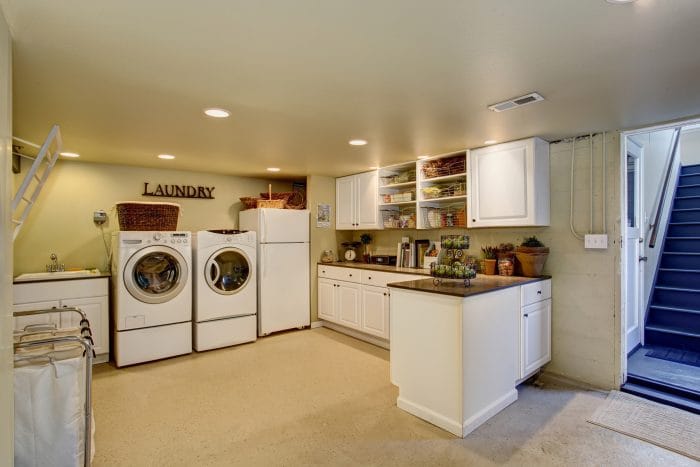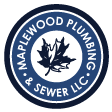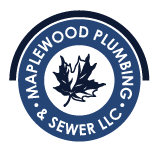
St. Louis Laundry Room Plumbing Specialists for 40+ Years
Whether you have a dedicated laundry room, or your washer and dryer are located in your basement or another area of your home, your washer and dryer require specific parts to do their work correctly.
Laundry Drain Parts
Knowing all of the components that make up your washing machine will help you understand how it works—in turn, helping you fix potential drain problems that might crop up. So, let’s start with the basics. These are the 10 parts of a washing machine.
Agitator – The agitator is located within the inner tub of the washing machine. It’s what causes your clothes to move around inside, lifting dirt and stains from the fabric. Some models have an impeller instead of an agitator, but they work in much the same way.
Circuit board – The circuit board tells the control panel and wash cycles what to do. It also controls functions such as the water level and how much detergent to dispense.
Control panel – The control panel is located on the top or front of your washing machine. This is how you choose your settings and wash cycles.
Drainpipe – The drainpipe is what moves all the dirty water from the tub after washing a load of laundry.
Heating element – The heating element heats the water for cycles that require warm or hot water. Not all washing machines have a heating element.
Motor – The washing machine motor powers the movement of your agitator or impeller.
Timer – The timer can be set manually or automatically to specific wash times for laundry cycles. Whether or not your washing machine has a timer depends on the model you have.
Tub – Also called the drum, your washing machine has both an inner tub and an outer tub. The inner tub is where you place your clothes to be washed. This tub is perforated and moveable. The outer tub functions as a support for the inner tub and holds water during wash cycles.
Water inlet valve – Water inlet valves are attached to the water lines and open and close based on the size of the load and how much water is needed for each wash cycle.
Water pump – Water pumps circulate water during a wash cycle and drain the water when a washing cycle is finished. Your model may have one water pump that performs both of these actions, or two (one for each).
In order for it to work correctly, your washing machine needs a laundry standpipe to connect the drain hose to your home’s waste stack. While it might be tempting to simply connect your washer to any other convenient drain line, doing so increases the risk of water overflow and sewer fumes.
TO PROPERLY DRAIN YOUR WASHING MACHINE, YOU’LL NEED TO HAVE THREE COMPONENTS:
- Standpipe. Standpipes should be at least 2” in diameter and large enough to accept the washing machine’s drain hose. (At one time, Residential Code allowed for 1 ½” standpipes, but that size is no longer sufficient for newer washing machines.) Laundry standpipes must be tall enough to extend past the washing machine’s overflow line—typically 30-36” in height, or 18-30” above the trap.
- P-trap. P-traps prevent hazardous and potentially flammable sewer gases from entering your home. Any fixture connected to a waste line must have a P-trap. The trap should be 6-18” from the floor. It is critical to maintain the correct pitch in the horizontal pipe connecting the trap to the waste stack.
- Pipes that aren’t vented are at great risk of overflowing and releasing harmful gases. In the case of laundry standpipes, the vent should be at least 1 ½” in diameter and located within 5 feet of the trap.
Soapy puddles on the floor of your laundry room, don’t necessarily mean your washing machine has gone bad. More likely, your laundry drain has a stubborn clog.
What Causes Laundry Drains to Clog?
There are several reasons your laundry drain can clog. Here are the most common culprits:
Soap residue. Just like with your home’s sink drains, soap can leave behind a film or residue that can build upover time causing a clog.
Dirt and debris. A washing machine’s job is to clean clothes, which means dirt and debris are constantly being washed down the drain. Eventually, all of that yuck can develop into a clog.
Dryer lint. You see how much lint fills up your dryer filter, right? That lint and related elements can find their way into the drain and gunk up your pipes, causing a clogged laundry drain.
Broken drainpipe. If your drainpipe isn’t working correctly, it can cause the drain to clog, along with other plumbing-related issues.
Laundry Drain Maintenance
Regular maintenance of your laundry drain can help to prevent clogs.
- Install a lint catcher on the end of the drainpipe and clean it out monthly. Lint catchers are made of either metal or fabric and are an inexpensive method of preventing fuzz from stopping up the drain. (If you’re the DIY-type, you can even make a lint catcher out of pantyhose.)
- Treat the drain with enzymes to keep soap scum to a minimum.
- Clean out the drain regularly with a snake—before you have a problem.
- For some homeowners, draining the washer into a utility sink is the best way to avoid laundry drain Sinks allow you to easily add enzymes when necessary, and mesh lint sink stoppers are inexpensive and effective.
- It’s a good idea to install a washing machine drain pan to catch overflowing water in the future, particularly if you have an older home with smaller-capacity pipes.
What to do if you have a clogged laundry drain
If you already have a clogged washing machine drain, there are a few DIY techniques you can perform to unclog the blockage.
STEP ONE: CLEAN THE TRAP.
To do this, place a bucket under the trap and open the seal so that the water and dirt flow into the bucket. Completely remove the trap and rinse it thoroughly before replacing it, then close the trap and reconnect the drain.
STEP TWO: MIX AND POUR.
If the drain is still clogged, the buildup is likely down deeper. Mix one package of baking soda with a bucket of boiling water. Remove the hose from the drain and pour the mixture down the drain (you may want to use a funnel to avoid spilling). Let sit for 10-15 minutes and then pour clean, hot water down the drain to see if it flows properly. If it does, you’ve successfully removed the clog.
STEP THREE: USE A DRAIN SNAKE.
Still clogged? Remove the trap from the drainpipe and slide the drain snake into the washer drain until you can’t push it any further. Rotate and move the snake up and down to find the clog, then pull the tool up and out of the drain. You should see the blockage come out with the tool. You may need to attach the snake to a drill for particularly stubborn clogs.
Note: We don’t recommend using chemical drain cleaners, as these can do more harm than good over time. If you do choose to pour drain cleaning solutions down the drain, be sure to let your plumber know if you end up calling for assistance. They will need to wear protective eyewear and gloves to prevent injury that can be caused by some drain cleaning chemicals.
If your washer still won’t drain properly, the actual pipe may be the problem, and you’ll need professional assistance. Call a plumber for drain cleaning service.
Maplewood Plumbing and Sewer has been cleaning laundry drains in St. Louis homes for more than 40 years. Contact us today at 314-645-6350 or here for more information or to request a bid.
We offer a one-year warranty on all parts and labor excluding washers.
We are also experts in kitchen plumbing, basement plumbing, bathroom plumbing, and tankless water heater installation.
Give us a call at 314-645-6350 or fill out the contact form here to request a bid.


